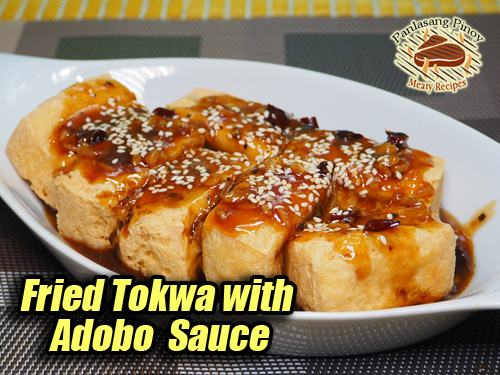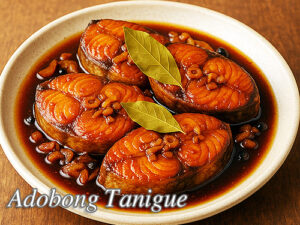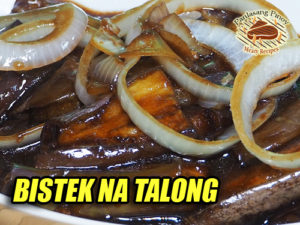Are you a vegetarian? I think this is not the right blog for you. But wait……although this is not the right site, this adobong tokwa recipe is absolutely right for you! Because this dish is meatless and the star ingredient here is tofu or tokwa. That’s right! you only need tofu to cook this dish but you need flavorings, spices and condiments to cook it. The a dish is also very easy to cook. You only need to fry the tofu then pour it with the adobo sauce. You will be surprised how tasty it is! It can be eaten as a viand or as an appetizer. I can also be paired with drinks as a “pulutan”. So try it! I’m sure you are going to love it!
Adobong Tokwa: A Delicious Twist on a Filipino Classic
When I first heard about adobong tokwa, I was hesitant. Adobo without meat? It seemed almost sacrilegious! Growing up in our small town in Batangas, adobo was synonymous with tender pork belly simmered to perfection or chicken steeped in savory, tangy sauce. But during a family reunion last year, my cousin Lito—who had recently embraced a plant-based lifestyle—brought a platter of this dish, and it changed the game for me.
Lito’s version of adobong tokwa was an instant hit. Crispy on the outside, soft on the inside, the tofu absorbed the rich adobo sauce like a sponge, creating a burst of flavors with every bite. Now, it’s a staple in my kitchen, especially for meatless Mondays or whenever I’m in the mood for something lighter yet equally satisfying.
What Makes Adobong Tokwa Special
For many Filipinos, adobo is a comforting reminder of home, each family boasting its own secret recipe. While the traditional versions lean heavily on meat, this tofu variation is a great option for those looking to eat lighter or reduce meat consumption without sacrificing flavor.
The magic of this dish lies in the tofu. Tokwa (the Filipino term for tofu) is an excellent canvas for flavor. When fried to a golden crisp, it develops a delightful texture that contrasts beautifully with the velvety adobo sauce. This versatility makes it a popular choice not just as a viand, but also as a pulutan, or bar chow, especially when paired with an ice-cold beer.
Cooking Tips for Perfect Fried Tokwa
If there’s one thing my Tita Rosa taught me about cooking tokwa, it’s to let it dry properly before frying. This step might seem trivial, but it’s crucial for achieving that coveted golden crust. Moisture is the enemy of crispy tofu! After cutting the tokwa, I like to lay it out in a colander for a few minutes to air-dry naturally.
When frying, don’t skimp on the oil. The tofu needs to be submerged at least halfway to cook evenly. I remember the first time I tried to fry tofu with just a thin layer of oil. The result was a soggy, uneven mess that my brother jokingly called “tokwa soup.” Lesson learned!
Once fried, the tofu becomes a blank slate ready to soak up the adobo sauce’s rich, tangy, and slightly spicy goodness.
The Secret Behind the Adobo Sauce
What sets adobo apart from other dishes is its balance of bold flavors—salty, tangy, sweet, and umami—all working in harmony. For this recipe, the combination of soy sauce, vinegar, and a touch of sugar creates the perfect base. A dash of oyster sauce adds depth, while siling labuyo (bird’s eye chili) lends a gentle heat.
One of the most important steps in making adobo sauce is allowing the vinegar to simmer without stirring for a few minutes. This technique is something I picked up from my Lola Teresita, who always warned us, “Huwag mo galawin!” (Don’t touch it!) The reason? Stirring too soon can prevent the vinegar from mellowing out, leaving it too sharp.
The final flourish is thickening the sauce with a cornstarch slurry. This creates a luxurious consistency that clings beautifully to the fried tofu, ensuring every bite is bursting with flavor.
A Brief History of Adobo
Did you know that adobo predates the Spanish colonization of the Philippines? While the name itself comes from the Spanish word adobar, which means “to marinate,” the technique of stewing meat in vinegar and salt was already practiced by early Filipinos. This method not only preserved food but also enhanced its flavor.
Over time, regional versions of adobo emerged, with ingredients and cooking styles varying based on local produce. In recent years, creative spins like adobong tokwa have gained popularity, proving that adobo’s appeal is as timeless as it is adaptable.
How to Serve and Enjoy Adobong Tokwa
Adobong tokwa is as versatile as it is delicious. It’s perfect as a main dish, paired with steaming white rice that soaks up the flavorful sauce. When my sister Mila visited from Davao last month, she surprised me by serving this dish as an appetizer, garnished with fried garlic and sesame seeds. It was a hit at our family dinner, with everyone asking for seconds—even my carnivorous uncle, who admitted he didn’t miss the meat!
If you’re hosting a gathering, try serving it as pulutan alongside your favorite drinks. The bold flavors make it a great companion for beer or even a classic calamansi juice.
Why You’ll Love This Dish
Adobong tokwa is more than just a recipe; it’s a testament to the creativity and adaptability of Filipino cuisine. Whether you’re looking to cut back on meat, try something new, or simply enjoy a delicious dish, this tofu adobo is sure to win you over.
As I sit here writing this, I can’t help but feel a pang of nostalgia for that family reunion where I first tasted adobong tokwa. It reminded me that food doesn’t just nourish the body—it connects us to our roots, our memories, and the people we love.
So, grab some tokwa, whip up this dish, and share it with those you hold dear. Who knows? It might just become your family’s next favorite recipe, too.
How to Cook Adobong Tokwa
Ingredients
- 5 pcs tokwa cut into 2 pcs
For the sauce:
- 2 Tbsp. soy sauce
- 3 cloves garlic minced
- 2 pcs siling labuyo
- 1/3 cup water
- 1/4 tsp. ground black pepper
- 1/2 Tbsp. sugar
- 1 Tbsp. oyster sauce
- 2 Tbsp. vinegar
- 1/2 Tbsp. cornstarch + 1 Tbsp. water for cornstarch slurry
- sesame seeds for garnishing
- cooking oil for frying
Instructions
How to Cook Adobong Tokwa:
- Cut the each tokwa into 2 pcs and put in a colander to dry for a few minutes.
- Heat cooking oil in a deep pan and fry the tokwa until golden brown. When cooked, remove from oil and drain in a colander.
- In the same pan, reduce the oil to 2 Tbsp. and saute garlic and siling labuyo for one minute.
- Then add the soy sauce, sugar, black pepper, water, oyster sauce and vinegar. Bring to a boil and do not stir for 3 minutes.
- Then add the cornstarch slurry and stir until the sauce is thick. Turn off heat.
- Arrange the fried tokwa in a platter and pour the adobo sauce on top. garnish with fried garlic or sesame seeds. Serve hot!
Video
Notes
Cooking Tips:
Dry the Tofu Before Frying
Properly drying the tofu is key to achieving a golden, crispy crust. After cutting the tokwa, place it in a colander or on a paper towel to remove excess moisture. This step ensures the tofu fries evenly and prevents oil splatter, making the texture irresistibly crunchy.Don’t Stir the Vinegar Too Soon
When adding vinegar to the sauce, let it boil undisturbed for about three minutes. This allows the acidity to mellow and blend seamlessly with the other ingredients, resulting in a balanced flavor. Stirring too early can cause the vinegar to retain a sharp, overpowering taste.Use Cornstarch Slurry for a Silky Sauce
A cornstarch slurry thickens the adobo sauce, making it velvety and perfect for coating the tofu. Mix equal parts cornstarch and water, then gradually add it to the sauce while stirring. This technique not only improves the sauce's texture but also helps it





